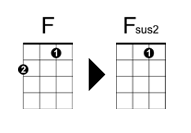Less Is More: Easy Chords That Sound Hard
By James Hill
Do your students a) have trouble holding two- and three-finger chords or b) want to start experimenting with jazz chords? Kill two birds with one stone using these easy-as-pie fingerings.
Hawaiian music is full of rich harmonies; the major 6 chord is very prominent, dominant 9 chords add a sophisticated spice and diminished chords are a common garnish. Take a beautiful tune like Hawaii Aloha, for instance. Played without these colourful extras the melody sounds just fine, but played with tastefully-added major 6 and dominant 9 chords, the arrangement rises to an entirely new level.
“In many cases, luxurious chords such as major 6s and dominant 9s are easier to play than their less-flavourful counterparts.”
Those new to the ukulele or those unfamiliar with chords beyond the major, minor, and dominant 7 varieties will be happy to know that in many cases, luxurious chords such as major 6s and dominant 9s are easier to play than their less-flavourful counterparts. With that in mind, let’s take a quick look at Hawaii Aloha, the free arrangement included in this issue, and see if we can make the harmonies a little more rich.
Click here to read this article in D6 tuning (a, d, f#, b).
There are only three chords in this piece: F, B, and C7. These can be “upgraded” to more colourful (and ergonomic) chords as follows:
First, let’s turn the F chord into an Fsus2 chord. To do this we’ll add the note g to the F chord. Why? Because the label “sus2” means, literally, “sustain the second.” In an F chord, the first (or “root”) is f, the second is g, the third is a, and so on. Sounds tricky but it couldn’t be simpler: just remove your middle finger and, voilà, you’re playing Fsus2! Note: for best results use an ukulele tuned with a high fourth string.
By the way, I’ve heard Lyle Ritz say that he never plays an F chord with two fingers; always the one-finger Fsus2 chord instead. If it’s good enough for Lyle, it’s good enough for me.
Now to the B chord. Major 6 chords figure prominently in Hawaiian music so let’s turn this into a B6 chord. Now is your chance to play the B chord the way you’ve always wanted to: without that pesky ring finger on the fourth string! Simply lift your third finger so that the fourth string is open. That’s all there is to it! It’s easier to play and it sounds better. What more could you ask for?
Finally, the C7. Let’s “upgrade” it to a C9. What note do we need to add? To find out, just count nine steps starting on the note c: c, d, e, f, g, a, b, c, d. So, we'll add the note d to the C7 chord to get C9 (tip: next time, don’t count nine steps, just think one step higher than the root of the chord). Add a d note with your middle finger and you’re playing a C9 chord. It’s that simple.
Experiment with these new, colourful chords and use your ear to determine when they’re appropriate. Remember: with greater knowledge comes greater responsibility! Use your new chords wisely and tastefully and you’ll enjoy a new level of harmonic richness in your playing.
James Hill is editor of Ukulele Yes! and co-author of Ukulele in the Classroom, a new series of ukulele method books for students of all ages. Visit www.ukuleleintheclassroom.com for more.






This month, Cynthia Kinnunen gives us some intervalactic tactics
Building recognition of intervals aurally (by ear) and on the page (by sight) helps to improve many aspects of our musical learning, including sight reading, sight singing, harmonizing and more! But knowing where to begin teaching intervals can leave us feeling like we’re on another planet.